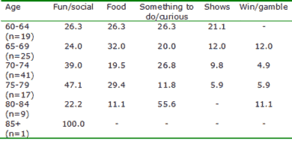The WAGER Vol. 7(33) – Gambling and The Elderly: Real or Imagined Risk?
Knowledge of cultural presumptions can drastically affect individuals’ thoughts, behaviors, and feelings. For example, recent research suggests that subtle exposure to stereotypes about the elderly affects elderly individuals’ memory quality, physical agility, and decision-making about living (Levy, 1996, 2000; Levy, Ashman, & Dror, 2000). This week the WAGER reviews a recent publication by Hope and Havir (2002) that expresses concern that cultural presumptions of elderly vulnerability to problem gambling might be premature and could unnecessarily lead to self-perceptions of vulnerability among this segment of the population—resulting in avoidance of potentially socially beneficial gambling outings.
This study had two phases. In Phase One the researchers mailed questionnaires to 1000 elderly individuals listed on a Minnesota senior center mailing list. Questionnaires included items about respondents’ demographics, gambling behavior, and motivation for gambling. The response rate was 14.6% (68% female). In Phase Two, Hope and Havir contacted individuals who agreed to participate in one-on-one interviews. The authors were able to interview 22 of these individuals. Because the response rate for Phase One was so small, and the interview rate for Phase Two was even smaller (2.2% of total mailing), the WAGER will restrict its discussion to Phase One data. Figure 1 reports elderly participants’ self-reported reasons for gambling.
Table 1: Proportion of Elderly Endorsement by Reason for Gambling and Age Group (Hope & Havir, 2002)
Most elderly respondents reported going to casinos for fun, food, curiosity, or shows. The smallest proportion of individuals reported going to casinos to win or gamble. Based on a report by Laundergan, Schaefer, Eckhoff, & Pirie (1990), Hope and Havir identified the 6.2% of elderly respondents who said they went to casinos to win or gamble as potential problem gamblers. Interestingly, Hope and Havir also noted that 5.5% of the sample self-reported that they thought they had a problem with gambling.
Hope and Havir use these results to suggest that viewing the elder gambler as at-risk might be a misperception; almost 94% of respondents reported gambling for what the authors consider non-problematic reasons. Although their measure of problem gambling is unconventional, consistently, meta-analytic estimates of non-elderly adults using standard measures report that between 4-6% of adults experience some problems due to gambling (Shaffer, Hall, & Vander Bilt, 1999). It is possible then, that as a culture we are exaggerating the increased risk of elder gamblers.
This study had a number of important limitations. These include the self-selection of participants, the restricted study population (i.e., one senior center in MN), the extremely low study response rate, and the unconventional means of assessing problem gambling. Further, the sample was overwhelmingly female. Thus, the sample might not generalize to a broader population, including the targeted study population.
Hope and Harvin wisely suggest that society should be cautious to not let personal biases result in widespread cultural presumptions that ultimately could harmfully affect the targets of those presumptions. Scientists should be similarly cautious. If scientists succumb to biases such as ageism, they run the risk of being advocates, rather than independent observers. Unfortunately, it is not possible, based on this research, to make definitive statements about elderly vulnerability to problem or pathological gambling. The authors’ claims of minimal risk are as premature as others’ claims of high risk. As research progresses, we will get a better idea of the appropriate levels of concern for this population. Until then, professing that science has definitively determined the rate of risk for various age groups seems premature.
Comments on this article can be addressed to Debi LaPlante.
References
Hope, J., & Havir, L. (2002). You bet they’re having fun! Older Americans and casino gambling. Journal of Aging Studies, 16, 177
197.
Laundergan, J. C., Schaefer, J., Eckhoff, K., & Pirie, P. (1990). Adult survey of Minnesota gambing behavior: a benchmark, 1990. St. Paul, MN: Minnesota Department of Human Services, Mental Health Division.
Levy, B. (1996). Improving memory in old age through implicit self-stereotyping. Journal of Personality and Social Psychology, 71(6), 1092-1107.
Levy, B. (2000). Handwriting as a reflection of aging stereotypes. Journal of Geriatric Psychiatry, 33(1), 81-94.
Levy, B., Ashman, O., & Dror, I. (2000). To be or not to be: The effects of aging stereotypes on the will to live. Journal of Death and Dying, 40(3), 409-420.
Shaffer, H. J., Hall, M. H., & Vander Bilt, J. (1999). Estimating the prevalence of disordered gambling behavior in the United States and Canada: A research synthesis. American Journal of Public Health, 89, 1369-1376.
